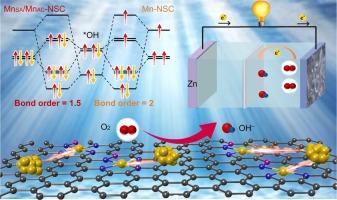Regulating spin configuration of Mn single atoms/Mn atomic clusters catalysts for high-performance zinc-air batteries
IF 17.1
1区 材料科学
Q1 CHEMISTRY, PHYSICAL
引用次数: 0
Abstract
Single-atom catalysts exhibit high efficiency and durability in oxygen reduction reactions (ORR). Among the factors influencing ORR activity, the spin configuration of single-atom catalysts can be effectively tuned through heteroatom doping, diatomic synergy, and coordination number regulation. However, systematic investigations into how atomic clusters modulate the spin configuration and catalytic behavior of single atoms in electrocatalysis remain scarce. Herein, Mn atomic clusters are employed to regulate the spin configuration of Mn single atoms, thereby enhancing their intrinsic activity as the primary active sites for high-performance zinc-air batteries. A porous carbon-based two-dimensional (2D) nanosheet (MnSA/MnAC-NSC) was synthesized, featuring co-existence of Mn atomic clusters and Mn single atoms. The involvement of Mn clusters induces a spin-state transition of Mn single atoms from high-spin to low-spin, which leads to σ* orbital occupation, facilitated OH⁻ desorption, and consequently accelerated reaction kinetics of the rate-determining step. MnSA/MnAC-NSC exhibited a high half-wave potential (0.85 V) for ORR, surpassing that of the Mn single atom counterpart (Mn-NSC) (0.81 V) and commercial Pt/C (0.75 V). Besides, a zinc-air battery with the MnSA/MnAC-NSC cathode could deliver a power density of 152.8 mW cm⁻2 and maintain enduring stability for over 80 h. This work paves the way for designing high-performance single-atom catalysts through cluster-induced spin-state modulation.

高性能锌空气电池中Mn单原子/Mn原子团簇催化剂的自旋构型调控
单原子催化剂在氧还原反应(ORR)中表现出高效率和耐久性。在影响ORR活性的因素中,单原子催化剂的自旋构型可以通过杂原子掺杂、双原子协同作用和配位数调节来有效调节。然而,关于原子团簇如何调节电催化中单个原子的自旋构型和催化行为的系统研究仍然很少。本文利用锰原子团簇来调节锰单原子的自旋构型,从而增强其固有活性,成为高性能锌空气电池的主要活性位点。合成了Mn原子团簇和Mn单原子共存的多孔碳基二维纳米片(MnSA/ mnc - nsc)。Mn团簇的参与引起Mn单原子自旋态从高自旋到低自旋的转变,导致σ*轨道占据,促进了OH -解附,从而加速了反应动力学的速率决定步骤。MnSA/ mnc - nsc在ORR中具有较高的半波电位(0.85 V),超过Mn单原子对应物(Mn- nsc) (0.81 V)和商用Pt/C (0.75 V)。此外,采用MnSA/ mnc - nsc阴极的锌空气电池可以提供152.8 mW cm - 2的功率密度,并保持80小时以上的持久稳定性。这项工作为通过团簇诱导自旋态调制设计高性能单原子催化剂铺平了道路。
本文章由计算机程序翻译,如有差异,请以英文原文为准。
求助全文
约1分钟内获得全文
求助全文
来源期刊

Nano Energy
CHEMISTRY, PHYSICAL-NANOSCIENCE & NANOTECHNOLOGY
CiteScore
30.30
自引率
7.40%
发文量
1207
审稿时长
23 days
期刊介绍:
Nano Energy is a multidisciplinary, rapid-publication forum of original peer-reviewed contributions on the science and engineering of nanomaterials and nanodevices used in all forms of energy harvesting, conversion, storage, utilization and policy. Through its mixture of articles, reviews, communications, research news, and information on key developments, Nano Energy provides a comprehensive coverage of this exciting and dynamic field which joins nanoscience and nanotechnology with energy science. The journal is relevant to all those who are interested in nanomaterials solutions to the energy problem.
Nano Energy publishes original experimental and theoretical research on all aspects of energy-related research which utilizes nanomaterials and nanotechnology. Manuscripts of four types are considered: review articles which inform readers of the latest research and advances in energy science; rapid communications which feature exciting research breakthroughs in the field; full-length articles which report comprehensive research developments; and news and opinions which comment on topical issues or express views on the developments in related fields.
 求助内容:
求助内容: 应助结果提醒方式:
应助结果提醒方式:


